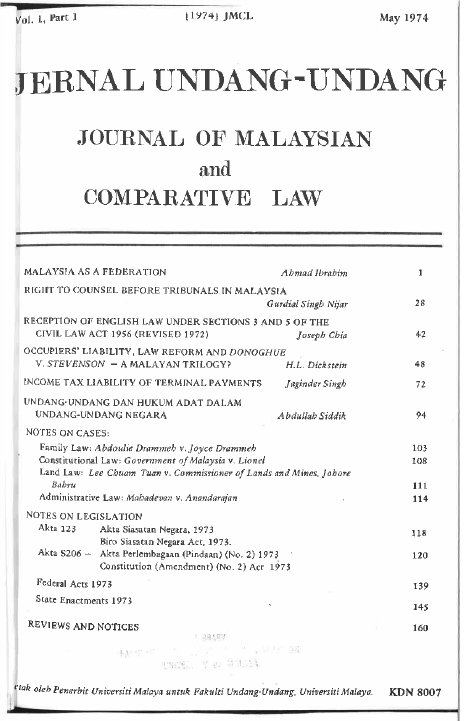MALAYSIA AS A FEDERATION
Abstract
The idea of a federation in Malaysia is not entirely new. Negri Sembilan originally consisted of nine States around Malacca who when they broke away from Malacca tutelage constituted a federation. During the nineteenth century there was violent dissension among the rulers of the various states of the federation and the British intervened. By 1889 all the rulers had accepted British protection after which some attempt at amalgamation was made and a federation of only six States was established in 1895. In 1898 they were made into a unitary State for most purposes with its capital at Seremban and the six States (Jelebu, Johol, Rembau, Sri Menanti, Sungai Ujung and Tampin),although they retain their Ruling Chiefs and customs, are headed by one legislature, one executive and a Yang di Pertuan Besar, who is elected by the Ruling Chiefs from among the members of the royal family of Sri Menanti.
The original federation of Negri Sembilan had no written Constitution but was based on the customary law and customary practices. Under the Malay form of federation, the office of Ruler or Yang di Pertuan Besar was a foreign, originally Hindu concept, which had been uneasily absorbed in the Minangkabau tribal system. The Yang di Pertuan Besar had the divine right of one whose ancestors had been the incarnation of Hindu Gods and who under Islam regarded himself the vicegerent of God on earth, but he had no real authority. He could levy no taxes except fees for cock fighting. For his maintenance he lived on land inherited from the tribal wife of the founder of the royal house and he was given formal traditional presents at his installation and on the occasion of marriages and other feasts. He was supreme arbiter and judge, if the territorial chiefs chose to invite him to adjudicate, which they never did. The Yang di Pertuan Besar should have been first in a State Council, but no council ever met, for the four territorial chiefs or Undangs, having got themselves absorbed into Minang-kabau polity by accepting uterine descent and conforming to matriarchal custom, regarded themselves as petty kings and never collaborated except when threatened by foreign invasion. Below the Undang were the Lembagas, the real chiefs of the matri!ineal Minangkabau tribes. The Lembaga was elected and under the Malay adat he had the power of mark-ing the boundaries of tribal lands and settling the transmission of property on death or divorce and he had jurisdiction in cases of lesser crimes, torts and debts. The Lembaga's subordinates were the elders (bampa) elected by the members of the sub-tribes.



